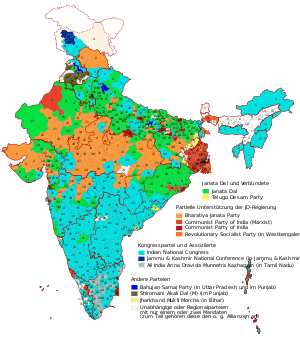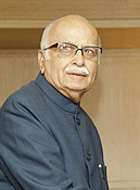Indian general election, 1989
|
| |||||||||||||||||||||||||||||||||||||
| |||||||||||||||||||||||||||||||||||||
All 545 seats in the Lok Sabha 273 seats were needed for a majority | |||||||||||||||||||||||||||||||||||||
|---|---|---|---|---|---|---|---|---|---|---|---|---|---|---|---|---|---|---|---|---|---|---|---|---|---|---|---|---|---|---|---|---|---|---|---|---|---|
| |||||||||||||||||||||||||||||||||||||
 | |||||||||||||||||||||||||||||||||||||
| |||||||||||||||||||||||||||||||||||||
General elections were held in India in 1989 to elect the members of the 9th Lok Sabha.[2] V. P. Singh united the entire disparate spectrum of parties including regional parties such as the Telugu Desam Party, the Dravida Munnetra Kazhagam, and the Asom Gana Parishad, forming the National Front with N.T.Rama Rao as President and V. P. Singh as convenor with additional outside support from the Bharatiya Janata Party and Communist Party of India (Marxist) led Left front they defeated Rajiv Gandhi's Congress (I) in the 1989 parliamentary elections.[3][4]
Background
The 1989 Indian general election were held because the previous Lok Sabha has been in power for a five years, and the constitution allowed for new elections. Even though Rajiv Gandhi had won the last election by a landslide, this election saw him trying to fight off scandals that had marred his administration.
The Bofors scandal, rising terrorism in Punjab, the civil war between LTTE and Sri Lankan government were just some of the problems that stared at Rajiv's government. Rajiv's biggest critic was Vishwanath Pratap Singh, who had held the portfolios of the finance ministry and the defence ministry in the government. During Singh's term as defence minister it was rumoured that he possessed damaging information about the Bofors defence deal that could ruin Rajiv's reputation.
But Singh was soon sacked from the Cabinet and he then resigned from his memberships in the Congress and the Lok Sabha. He formed the Jan Morcha with Arun Nehru and Arif Mohammad Khan and re-entered the Lok Sabha from Allahabad. Witnessing V P Singh's meteoric rise on national stage, Rajiv tried to counter[5] him with another prominent Rajput stalwart Satyendra Narain Singh but failed eventually
Premiership
V.P. Singh as Prime Minister
V. P. Singh who was the head of the Janata Dal was chosen leader of the National Front government .[6]His government fell after V. P. Singh along with Lalu Prasad Yadav government , had Advani arrested in Samastipur, Bihar and stopped his Ram Rath Yatra which was going to the Babri Masjid site in Ayodhya on 23 October 1990 and the Bharatiya Janata Party withdraw support to the V.P. Singh government which lost a parliamentary vote of confidence on 7 November 1990.[7]
Chandra Sekhar as Prime Minister
Chandra Shekhar broke away from the Janata Dal with 64 MPs and formed the Samajwadi Janata Party in 1990. He got outside support from the Congress and became the 9th Prime Minister of India. He finally resigned on 6 March 1991, after the Congress alleged that the government was spying on Rajiv Gandhi.
 |
|---|
| This article is part of a series on the politics and government of India |
|
|
|
|
|
———————
Legislatures: ——————— Urban bodies: |
Results
9th Lok Sabha constituted.[8]
See also
References
- ↑ http://www.ipu.org/parline-e/reports/arc/2145_89.htm
- ↑ "Elections 1989: Congress(I) faces prospect of being routed in Bihar".
- ↑ "V. P. Singh, a Leader of India Who Defended Poor, Dies at 77". New York Times. 29 November 2008. Retrieved 6 October 2017.
- ↑ Indian Parliamentary Democracy. Atlantic Publishers & Dist. 2003. pp. 124–. ISBN 978-81-269-0193-7. Retrieved 6 October 2017.
- ↑ http://www.tribuneindia.com/2006/20060907/edit.htm
- ↑ "V. P. Singh: Prime Minister of India who tried to improve the lot of the poor". The Independent. 19 December 2008. Retrieved 6 October 2017.
- ↑ "India's Cabinet Falls as Premier Loses Confidence Vote, by 142-346, and Quits". New York Times. 8 November 1990. Retrieved 6 October 2017.
- ↑ "Archived copy" (PDF). Archived from the original (PDF) on 18 July 2014. Retrieved 25 May 2014.
.jpg)
.jpg)
